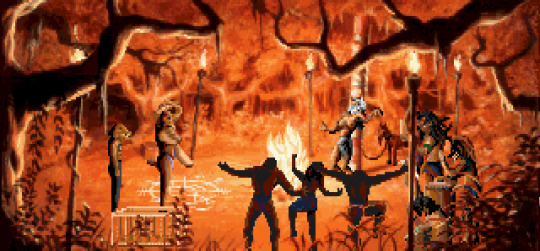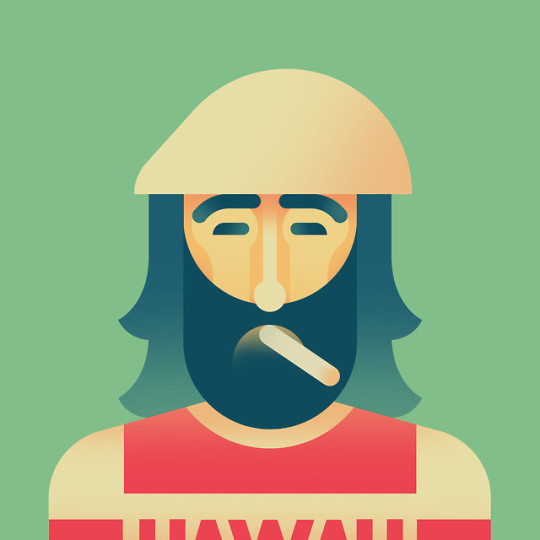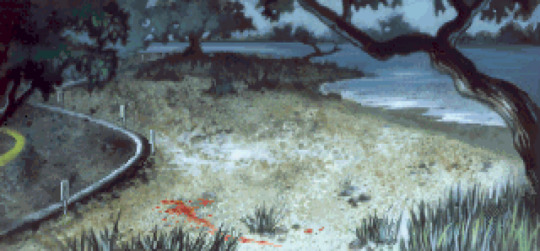#John Shroades
Photo





“Gabriel Knight: Sins of the Fathers” PC/Macintosh 1993
Art by John Shroades
33 notes
·
View notes
Photo



#Gabriel Knight#Sins of the Fathers#1993#Sierra Online#Jane Jensen#Adventure Games#darlou gams#John Shroades
38 notes
·
View notes
Photo





I love these graphics by John Shroades.
219 notes
·
View notes
Note
snapdragon for the ask thin
Snapdragon: Favorite mythical creature?
Here’s a fun fact about me: I was obsessed with mythical creatures when I was around six or seven. I had a book of them—Magical Creatures by Kate Torpie and John Shroades, I actually still have it, 10/10 would recommend—and I would read it over and over, never tiring of the illustrations and details of all these cross-cultural beings that I childishly believed in. Obviously, six-year-old me had a pretty long list of favorites, but now, the two that really stick out in my mind are nymphs and sirens. I guess even as a second grader, I was a big, useless lesbian.
1 note
·
View note
Photo

Spend time with true friends
who understand you.
Illustrated by John Shroades.
0 notes
Text
To obtain a pass in the Foundation Diploma in Art and Design you must be able to demonstrate that certain bench barks have been reached in your Final Major Project.
There are three levels Pass, Merit & Distinction, these are defined in Unit 10 as described below with a summary of how I feel they have been achieved.
Unit 10 Appraisal
Pass.
P1. Propose a time-bound Final Major Project.
Refer to Final Major Project Statement of Intent.
P2. Research relevant historical, cultural and contemporary sources.
Historical & Cultural content from various sources.
Museums National Waterways Museum Gloucester,
Books Kennet and Avon Canal Kenneth R. Crew
Narrow Boat L.T.C. Rolt
The Amateur Boatwomen Eily Gayford
Bradshaws canals & Navigable Rivers of England & Wales
Canal Boats John M. Hill
Contemporary sources.
Websites Canal & River Trust
Waterways World Magazine
Canalboat Magazine
Towpath Newspaper
Google Search
Books The Narrowboat Builder’s Book Graham Booth
Paint Roses & Castles Anne Young
The Water Road Paul Gogarty
Contemporary Artists
Margret Fairhead Textile Artist
Paul Hipkiss Printmaker
Peter Shroad Woodcut & Linocut relief
Freya Hajade Photographer
Charlotte Ashman Printer – Linocut
Eric Gaskell Printer
Lynn Jeffery Photo/Silk screen prints
P3. Apply appropriate references to the realisation of the Final Major Project.
The initial idea for the project was to look at how people make homes on the canal network and highlight the pour conditions that a number of people find themselves living in, with interest how these boats are decorated and adorned with creativity. To do this I visited a stretch of the Kennet and Avon Canal between Bradford on Avon and the Dundas Aqueduct. On these visits photographs were taken of many of the boats along this section on the canal, a number of which to be used as reference images for the final work. The final subject was chosen from a short list of images. Visits to museums helped to build the historical background.
P4. Appraise the effectiveness of the Final Major Project development.
While I had an idea of what I wanted to show, at the start I was not sure which medium would be used to best complete the body of work. A number of ideas were explored but I felt that they did not encapsulate the concept of showing the living conditions. Finally I decided to use materials that would be readily available by the people living under these conditions and the use of wooded pallets and other scrap materials became the obvious choice. By using the pallet as the base/support and not hiding, it proved to be very effective in helping the observer get a glimpse of life for some people on the canals.
P5. Identify and follow up issues, responses and dilemmas.
From the start the main issue/dilemma was to be how best to show the body of work, what format/material. Through research, trial and experimentation with different processes, drawing, ceramics, printing and etching, for various reasons practicality, cost, availability etc. and by a process of appraisal I eliminated all of the original ideas, all of which helped to decide the method of production of the final piece but to still include all the above to be displayed with and support the final piece.
P6. Reflect on Exploratory and Pathway Stages in relation to the FMP.
Along with my experimentation and research in the physical processes involved in producing the final body or work. On a number of occasions I visited the Kennet and Avon canal to build a library of photographic images of vessels and narrowboats along the canal. These helped me to see firsthand the conditions for some. This was also part of a previous pathway project ‘Mend & Repair’ where I looked at how people used and adapted items for use, not necessarily their original purpose. From this I was introduced to wider issues for many people who live along the network of UK canals, mainly their living conditions and culture.
P7. Propose alternative resolutions.
An alternative considered was to construct a large model or mock up of a typical boat. That way the observer would be better able to investigate and understand to living conditions. The idea would be to build two mock ups, one based historical on a working boat from the early to mid 19th century and the other a contemporary boat. So that you could compare the life styles, culture and art.
This was discounted mainly on the practicality, cost and time constraints.
P8. Exhibit a Final Major Project.
Due to Covid 19 it will not be possible to exhibit but to investigate how the work and all its supporting material could be displayed I built a 1/12 scale maquette for an assumed exhibition space of 2.4m x 2.4m, containing replicas of the main piece and the supporting drawing, books, sketchbook, Ceramic tiles, Linocut prints and a digital projection showing various canal images.
Merit.
M1. Manage a personal synthesis of in-depth research to inform and invigorate considered contextual referencing in the Final Major Project.
My visits to the canal became invaluable in understanding how a derelict boat could be repaired and adapted using mainly salvaged materials. This heavily influenced my choice of materials and how they should be applied. The use of the wooded pallet was fundamental and the fact that it would remain intact. If I had dismantled the pallet and reassembled the wood to form a smooth perfect support, then its identity as a salvaged pallet would have been lost. The people who live on these boats live in a close community and are very suspicious of strangers. This made it very difficult to make contact. I had hoped that one avenue would be through the floating chapel and its lay preachers but unfortunately these proved to be just as elusive.
M2. Sustain levels of commitment and attention to detail within the Final Major Project.
At each stage I reviewed and appraised my progress with input from various tutors. A timetable was included in the original Statement of intent and was used as the guide by which my work and progress was to be judged. At each stage I was ahead of the proposed timetable enabling me to rework any items that I felt didn’t reach the required standard. As an example my initial thoughts were to produce a large detail drawing of the chosen subject, but once I had completed a study drawing I realised that even though I had created a drawing that was a true image of the chosen subject it didn’t fully fulfil the criteria in that information contained within the drawing was not enough for an observer to fully understand the living conditions for some that live along the canal. I also felt that I had chosen an easy option in that I had produced work similar to this before and I should look for an option that would stretch me and encourage me to work in a different way. The study had been a worthwhile in that it showed that the subject, the composition and size of the work all worked together.
M3. Demonstrate the capacity to devise and construct a substantive body of work demonstrating consistent quality.
Along with the main body of work the wooden pallet mounted collage and its supporting materials books, drawings etc. a sketchbook was maintained, in this all my ideals were recorded and developed. During the initial research and subsequent test pieces, each item was completed to my best ability and needed to reach a standard that I would be happy to show and that it would be successful as a standalone item in its own right. With regard to the study drawing and the linocut print I felt that this had been achieved but with regard to the ceramic tiles, unfortunately with Covid 19 closing the ceramics workshop I was not able to complete the work but based on what had been achieved, I feel that if I had been able to finish it would have been of an acceptable standard.
M4. Demonstrate the ability to objectively reflect on the development of the Final Major Project, devising appropriate quality solutions.
At regular tutorials my progress was discussed with suggestions on how best to proceed. The main issue was how best to demonstrate/show the work to achieve the desired result, mainly, which medium to use. After various trials with different processes from the initial idea’s drawing, printing, ceramics & etching it became clear that to follow the original concept of homeless and pour conditions I needed to rethink and consider what resources money and materials would be available to a person living on the canal and construct the work from these materials and various salvaged items using basic tools.
Another issue for me was how to construct the image. Normally if this was a drawing after the initial setting out I would work starting top left working to bottom right, fully completing the image as I go. If this was an oil painting I would work from the background to the foreground, working light over dark. Completing a collage was new to me and I found it needed a great deal of forward planing, working in different areas to try and achieve an image with depth, hopefully incorporating light and shadow.
M5. Work collaboratively in seeking out and using the advice of others to extend and develop the Final Major Project.
With regard to the etching, ceramics & printing I was working outside of my normal comfort zone. With the help of the college sculpture workshop technician, we discussed the pros and cons of different materials for laser etching and helped with a number of test samples. The college ceramic lecturer and technician advised me on the making and decorating of tile making and with the lino and woodcut printing I took advice and guidance from the lecturer. To explore woodcut in a little more depth I attended an introduction to woodcut printing course at the RWA Bristol. Regular tutorials helped to point me in the direction of sources of information along with constructive criticism. I regularly posted work on Instagram and on my blog asking for comments and suggestions. Joining a WhatsApp group helped to keep the discussion going.
Through out the lock down period I maintained contact with tutors through regular Zoom online conference calls, where progress was discussed and advice given. This included advise on how to present the work. Using phone calls, texting, Whatsapp and by following fellow students Instagram and blogs I was able to keep in contact and we were able to advise and comment on each others work.
Distinction.
D1. Appraise and articulate critical decision making through the Final Major Project. Showing the ability to engage with original thinking, concepts and approaches.
There were a number of critical decisions that need to be made:-
· Initial subject
· Sources of information - contemporary and historical
· Materials to be used
· Resources available
· Final presentation
The subject matter was primarily influenced by a previous pathway project ‘Mend & Repair’ which introduced me to the conditions for some who live and work along the canals.
The available information from books, magazines, websites, museums and from my own visits to various canal locations, gave me a view of contemporary issues and with the historical evidence gave me enough to made decisions as to which direction to take the project.
Experimentation with a number of processes printing, drawing, ceramics and etching, along with the materials available influenced the decision with regard to the choice of martials to be used. The final choice, where possible was to use readily salvaged material.
Another critical factor was the availability of workshop resources. Through the making of test pieces in the sculpture, ceramics and printing workshop I was able to decide the practicality and skill level required for each process. The final decision was influenced by the subject itself and how a person living on the canal with very little resources would solve the problem.
For the final presentation a number of options were considered from building a mock up of historical and contemporary living spaces to display panels each side of a video presentation (refer to sketchbook). The end choice was dictated by the main piece of work being constructed from a wooden pallet and many of the support pieces mounted on pallets it felt right build a display platform for the main item and the digital projector from pallets. Refer to pictures of the scale maquette.
D2. Respond proactively, independently and imaginatively to challenges and constraints in the realisation of the final Major Project.
Being colour blind I would normally play safe and create a drawing or similar with little colour input, but with the subject matter and the way I had chosen to construct the work colour would be important in helping to give the subject depth and texture. To achieve this I found it necessary to experiment with water colour, acrylic and gouache. To achieve the look of delaminated plywood I experimented in various ways finally choosing to layer brown paper that had been stained with water colours. To achieve the rusting texture of the boats hull I layered ground chalk, charcoal and ground black, white and red soft pastels all fixed with hair spray. The main challenge was to reproduce the folded plastic sheets that covered the deck. This I finally achieved with bin liner plastic and tissue paper fixed to kitchen aluminium foil to make it more pliable and hold the shape. With the Covid 19 isolation it was necessary to find all I needed from my stock of materials and items around the house. In a way this would be just as a boat person would need to do. Overall this became a truly multimedia creation.
D3. Demonstrate the ability to apply a professional rigour and standard to the Final Major Project.
At regular intervals progress was appraised by tutors and myself to check that I was meeting the criteria as set down in the statement of intent and as defined by Unit 10. A number of factors were considered including the quality/standard of the work, progress within the time available and its relevance to the subject. At each appraisal the decisions were made as to overall quality of the work and were improvements could be made.
D4. Understand and apply informed self-critical judgement when identifying success potential in the Final Major Project.
The time given was sufficient for me to take time out and sit back and study the progress of the work. At times it was useful for me to be able leave the work and walk away, coming back a day later with a fresh eye. This was invaluable as at times I had become too close to the piece and by stepping back and returning to look as if for the first time I was able to be more subjective and critical and see areas that worked and those that didn’t and see clearly different possible solutions. When working in isolation it is important to try and see the work from another persons perspective and to see that it can be easily understood by others.
D5. Demonstrate the ability to proactively engage in critical debate that informs and extends the Final Major Project.
This project has only focussed on one aspect of life on the canals. The environment, economics and changes in the political landscape with all have an effect on the future of the canal network. The fact that many people are finding it almost impossible to afford their first home, many are looking for alternatives and for some living on a canal have become a popular option. With some regions already at capacity and along with the growth in popularity of recreational and holiday hire boats, with the increase in demand on limited resources this will create further problems for those who already live along the canals and will affect their life style. It would be interesting to revisit, monitor and record how these issues affect the boater’s unique culture.
0 notes
Photo

by John Shroades
#John Shroades#Little Red Riding Hood#Grey Wolf#art#illustration#painting#pictures#fairy tale#fantasy#Charles Perrot
3 notes
·
View notes





